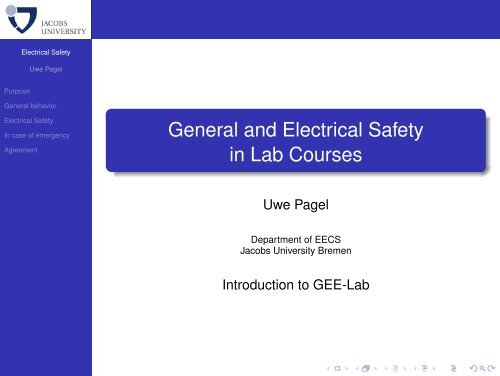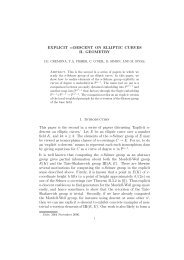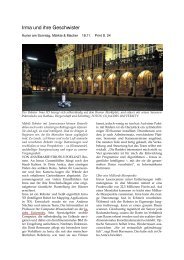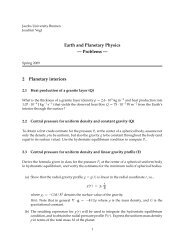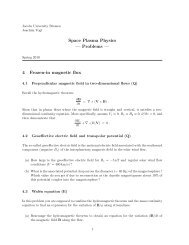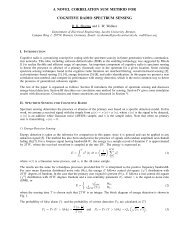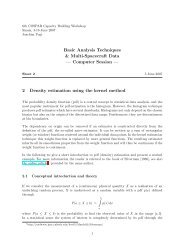General and Electrical Safety in Lab Courses - Faculty.jacobs ...
General and Electrical Safety in Lab Courses - Faculty.jacobs ...
General and Electrical Safety in Lab Courses - Faculty.jacobs ...
Create successful ePaper yourself
Turn your PDF publications into a flip-book with our unique Google optimized e-Paper software.
Purpose<br />
<strong>Electrical</strong> <strong>Safety</strong><br />
Uwe Pagel<br />
<strong>General</strong> behavior<br />
<strong>Electrical</strong> <strong>Safety</strong><br />
In case of emergency<br />
Agreement<br />
<strong>General</strong> <strong>and</strong> <strong>Electrical</strong> <strong>Safety</strong><br />
<strong>in</strong> <strong>Lab</strong> <strong>Courses</strong><br />
Uwe Pagel<br />
Department of EECS<br />
Jacobs University Bremen<br />
Introduction to GEE-<strong>Lab</strong>
Purpose<br />
<strong>Electrical</strong> <strong>Safety</strong><br />
Uwe Pagel<br />
<strong>General</strong> behavior<br />
<strong>Electrical</strong> <strong>Safety</strong><br />
In case of emergency<br />
Agreement<br />
Outl<strong>in</strong>e<br />
1 Purpose<br />
2 <strong>General</strong> behavior dur<strong>in</strong>g lab sessions<br />
3 <strong>Electrical</strong> <strong>Safety</strong><br />
4 Rules of conduct <strong>in</strong> case of emergency<br />
5 Agreement
Purpose<br />
<strong>Electrical</strong> <strong>Safety</strong><br />
Uwe Pagel<br />
<strong>General</strong> behavior<br />
<strong>Electrical</strong> <strong>Safety</strong><br />
In case of emergency<br />
Agreement<br />
Purpose<br />
give an overview about general behavior dur<strong>in</strong>g the lab<br />
<strong>and</strong> assure the safety when work<strong>in</strong>g <strong>in</strong> research <strong>and</strong><br />
teach<strong>in</strong>g labs<br />
ma<strong>in</strong> focus is electrical safety<br />
... <strong>and</strong>, fulfill requirements requested by German law<br />
Keep the follow<strong>in</strong>g facts <strong>in</strong> m<strong>in</strong>d when you are present <strong>in</strong> a<br />
laboratory. The rules must be followed at all times.
Purpose<br />
<strong>Electrical</strong> <strong>Safety</strong><br />
Uwe Pagel<br />
<strong>General</strong> behavior<br />
<strong>Electrical</strong> <strong>Safety</strong><br />
In case of emergency<br />
Agreement<br />
Purpose<br />
give an overview about general behavior dur<strong>in</strong>g the lab<br />
<strong>and</strong> assure the safety when work<strong>in</strong>g <strong>in</strong> research <strong>and</strong><br />
teach<strong>in</strong>g labs<br />
ma<strong>in</strong> focus is electrical safety<br />
... <strong>and</strong>, fulfill requirements requested by German law<br />
Keep the follow<strong>in</strong>g facts <strong>in</strong> m<strong>in</strong>d when you are present <strong>in</strong> a<br />
laboratory. The rules must be followed at all times.
Purpose<br />
<strong>Electrical</strong> <strong>Safety</strong><br />
Uwe Pagel<br />
<strong>General</strong> behavior<br />
<strong>Electrical</strong> <strong>Safety</strong><br />
In case of emergency<br />
Agreement<br />
Purpose<br />
give an overview about general behavior dur<strong>in</strong>g the lab<br />
<strong>and</strong> assure the safety when work<strong>in</strong>g <strong>in</strong> research <strong>and</strong><br />
teach<strong>in</strong>g labs<br />
ma<strong>in</strong> focus is electrical safety<br />
... <strong>and</strong>, fulfill requirements requested by German law<br />
Keep the follow<strong>in</strong>g facts <strong>in</strong> m<strong>in</strong>d when you are present <strong>in</strong> a<br />
laboratory. The rules must be followed at all times.
Purpose<br />
<strong>Electrical</strong> <strong>Safety</strong><br />
Uwe Pagel<br />
<strong>General</strong> behavior<br />
<strong>Electrical</strong> <strong>Safety</strong><br />
In case of emergency<br />
Agreement<br />
Purpose<br />
give an overview about general behavior dur<strong>in</strong>g the lab<br />
<strong>and</strong> assure the safety when work<strong>in</strong>g <strong>in</strong> research <strong>and</strong><br />
teach<strong>in</strong>g labs<br />
ma<strong>in</strong> focus is electrical safety<br />
... <strong>and</strong>, fulfill requirements requested by German law<br />
Keep the follow<strong>in</strong>g facts <strong>in</strong> m<strong>in</strong>d when you are present <strong>in</strong> a<br />
laboratory. The rules must be followed at all times.
Purpose<br />
<strong>Electrical</strong> <strong>Safety</strong><br />
Uwe Pagel<br />
<strong>General</strong> behavior<br />
<strong>Electrical</strong> <strong>Safety</strong><br />
In case of emergency<br />
Agreement<br />
<strong>General</strong> behavior dur<strong>in</strong>g lab sessions<br />
These rules apply for any work, <strong>in</strong> any lab!<br />
Your personal conduct should be <strong>in</strong> a way that nobody<br />
will be hurt <strong>and</strong> no equipment will be damaged.<br />
Never work alone!<br />
Wherever you are on campus you should know build<strong>in</strong>g<br />
name <strong>and</strong> room number! (e.g. Research I, Room 54)<br />
Inside a room you should know the escape route <strong>and</strong> the<br />
places of the telephone <strong>and</strong> the safety arrangements.
Purpose<br />
<strong>Electrical</strong> <strong>Safety</strong><br />
Uwe Pagel<br />
<strong>General</strong> behavior<br />
<strong>Electrical</strong> <strong>Safety</strong><br />
In case of emergency<br />
Agreement<br />
<strong>General</strong> behavior dur<strong>in</strong>g lab sessions<br />
These rules apply for any work, <strong>in</strong> any lab!<br />
Your personal conduct should be <strong>in</strong> a way that nobody<br />
will be hurt <strong>and</strong> no equipment will be damaged.<br />
Never work alone!<br />
Wherever you are on campus you should know build<strong>in</strong>g<br />
name <strong>and</strong> room number! (e.g. Research I, Room 54)<br />
Inside a room you should know the escape route <strong>and</strong> the<br />
places of the telephone <strong>and</strong> the safety arrangements.
Purpose<br />
<strong>Electrical</strong> <strong>Safety</strong><br />
Uwe Pagel<br />
<strong>General</strong> behavior<br />
<strong>Electrical</strong> <strong>Safety</strong><br />
In case of emergency<br />
Agreement<br />
<strong>General</strong> behavior dur<strong>in</strong>g lab sessions<br />
These rules apply for any work, <strong>in</strong> any lab!<br />
Your personal conduct should be <strong>in</strong> a way that nobody<br />
will be hurt <strong>and</strong> no equipment will be damaged.<br />
Never work alone!<br />
Wherever you are on campus you should know build<strong>in</strong>g<br />
name <strong>and</strong> room number! (e.g. Research I, Room 54)<br />
Inside a room you should know the escape route <strong>and</strong> the<br />
places of the telephone <strong>and</strong> the safety arrangements.
Purpose<br />
<strong>Electrical</strong> <strong>Safety</strong><br />
Uwe Pagel<br />
<strong>General</strong> behavior<br />
<strong>Electrical</strong> <strong>Safety</strong><br />
In case of emergency<br />
Agreement<br />
<strong>General</strong> behavior dur<strong>in</strong>g lab sessions<br />
These rules apply for any work, <strong>in</strong> any lab!<br />
Your personal conduct should be <strong>in</strong> a way that nobody<br />
will be hurt <strong>and</strong> no equipment will be damaged.<br />
Never work alone!<br />
Wherever you are on campus you should know build<strong>in</strong>g<br />
name <strong>and</strong> room number! (e.g. Research I, Room 54)<br />
Inside a room you should know the escape route <strong>and</strong> the<br />
places of the telephone <strong>and</strong> the safety arrangements.
Purpose<br />
<strong>Electrical</strong> <strong>Safety</strong><br />
Uwe Pagel<br />
<strong>General</strong> behavior<br />
<strong>Electrical</strong> <strong>Safety</strong><br />
In case of emergency<br />
Agreement<br />
<strong>General</strong> behavior dur<strong>in</strong>g lab sessions<br />
These rules apply for any work, <strong>in</strong> any lab!<br />
Your personal conduct should be <strong>in</strong> a way that nobody<br />
will be hurt <strong>and</strong> no equipment will be damaged.<br />
Never work alone!<br />
Wherever you are on campus you should know build<strong>in</strong>g<br />
name <strong>and</strong> room number! (e.g. Research I, Room 54)<br />
Inside a room you should know the escape route <strong>and</strong> the<br />
places of the telephone <strong>and</strong> the safety arrangements.
Purpose<br />
<strong>Electrical</strong> <strong>Safety</strong><br />
Uwe Pagel<br />
<strong>General</strong> behavior<br />
<strong>Electrical</strong> <strong>Safety</strong><br />
In case of emergency<br />
Agreement<br />
<strong>General</strong> behavior dur<strong>in</strong>g lab sessions<br />
No food or dr<strong>in</strong>ks <strong>in</strong> the <strong>Lab</strong>. Keep the work area clean<br />
<strong>and</strong> tidy all the times.<br />
Be prepared for the work.<br />
Follow all written <strong>and</strong> verbal <strong>in</strong>structions carefully.<br />
In case of problems, ask before you proceed.<br />
Perform only authorized experiments.
Purpose<br />
<strong>Electrical</strong> <strong>Safety</strong><br />
Uwe Pagel<br />
<strong>General</strong> behavior<br />
<strong>Electrical</strong> <strong>Safety</strong><br />
In case of emergency<br />
Agreement<br />
<strong>General</strong> behavior dur<strong>in</strong>g lab sessions<br />
No food or dr<strong>in</strong>ks <strong>in</strong> the <strong>Lab</strong>. Keep the work area clean<br />
<strong>and</strong> tidy all the times.<br />
Be prepared for the work.<br />
Follow all written <strong>and</strong> verbal <strong>in</strong>structions carefully.<br />
In case of problems, ask before you proceed.<br />
Perform only authorized experiments.
Purpose<br />
<strong>Electrical</strong> <strong>Safety</strong><br />
Uwe Pagel<br />
<strong>General</strong> behavior<br />
<strong>Electrical</strong> <strong>Safety</strong><br />
In case of emergency<br />
Agreement<br />
<strong>General</strong> behavior dur<strong>in</strong>g lab sessions<br />
No food or dr<strong>in</strong>ks <strong>in</strong> the <strong>Lab</strong>. Keep the work area clean<br />
<strong>and</strong> tidy all the times.<br />
Be prepared for the work.<br />
Follow all written <strong>and</strong> verbal <strong>in</strong>structions carefully.<br />
In case of problems, ask before you proceed.<br />
Perform only authorized experiments.
Purpose<br />
<strong>Electrical</strong> <strong>Safety</strong><br />
Uwe Pagel<br />
<strong>General</strong> behavior<br />
<strong>Electrical</strong> <strong>Safety</strong><br />
In case of emergency<br />
Agreement<br />
<strong>General</strong> behavior dur<strong>in</strong>g lab sessions<br />
No food or dr<strong>in</strong>ks <strong>in</strong> the <strong>Lab</strong>. Keep the work area clean<br />
<strong>and</strong> tidy all the times.<br />
Be prepared for the work.<br />
Follow all written <strong>and</strong> verbal <strong>in</strong>structions carefully.<br />
In case of problems, ask before you proceed.<br />
Perform only authorized experiments.
Purpose<br />
<strong>Electrical</strong> <strong>Safety</strong><br />
Uwe Pagel<br />
<strong>General</strong> behavior<br />
<strong>Electrical</strong> <strong>Safety</strong><br />
In case of emergency<br />
Agreement<br />
<strong>General</strong> behavior dur<strong>in</strong>g lab sessions<br />
No food or dr<strong>in</strong>ks <strong>in</strong> the <strong>Lab</strong>. Keep the work area clean<br />
<strong>and</strong> tidy all the times.<br />
Be prepared for the work.<br />
Follow all written <strong>and</strong> verbal <strong>in</strong>structions carefully.<br />
In case of problems, ask before you proceed.<br />
Perform only authorized experiments.
Purpose<br />
<strong>Electrical</strong> <strong>Safety</strong><br />
Uwe Pagel<br />
<strong>General</strong> behavior<br />
<strong>Electrical</strong> <strong>Safety</strong><br />
<strong>Electrical</strong> characteristic<br />
Impact of current<br />
Range of dangers<br />
Other risks<br />
Technical safety arrangements<br />
Example<br />
Rules<br />
In case of emergency<br />
Agreement<br />
<strong>Electrical</strong> <strong>Safety</strong><br />
<strong>Electrical</strong> characteristic of human body<br />
Impact of electrical current to the human body will cause<br />
serious <strong>in</strong>juries <strong>and</strong> may be reason of accidents or<br />
damage.<br />
The strength of the impact depends on the current <strong>and</strong><br />
the way it takes through the body.<br />
The current flow is dependent on the voltage <strong>and</strong> the<br />
resistance. (Ohm’s Law!)<br />
Diagram of the resistance of human body:<br />
Upper curve: dry sk<strong>in</strong>, small jo<strong>in</strong>ts<br />
Lower curve: wet sk<strong>in</strong>, strong jo<strong>in</strong>ts<br />
The resistance is further dependent on<br />
the environment. (Humidity, floor, Clothes,<br />
Shoes, etc.)
Purpose<br />
<strong>Electrical</strong> <strong>Safety</strong><br />
Uwe Pagel<br />
<strong>General</strong> behavior<br />
<strong>Electrical</strong> <strong>Safety</strong><br />
<strong>Electrical</strong> characteristic<br />
Impact of current<br />
Range of dangers<br />
Other risks<br />
Technical safety arrangements<br />
Example<br />
Rules<br />
In case of emergency<br />
Agreement<br />
<strong>Electrical</strong> <strong>Safety</strong><br />
<strong>Electrical</strong> characteristic of human body<br />
Impact of electrical current to the human body will cause<br />
serious <strong>in</strong>juries <strong>and</strong> may be reason of accidents or<br />
damage.<br />
The strength of the impact depends on the current <strong>and</strong><br />
the way it takes through the body.<br />
The current flow is dependent on the voltage <strong>and</strong> the<br />
resistance. (Ohm’s Law!)<br />
Diagram of the resistance of human body:<br />
Upper curve: dry sk<strong>in</strong>, small jo<strong>in</strong>ts<br />
Lower curve: wet sk<strong>in</strong>, strong jo<strong>in</strong>ts<br />
The resistance is further dependent on<br />
the environment. (Humidity, floor, Clothes,<br />
Shoes, etc.)
Purpose<br />
<strong>Electrical</strong> <strong>Safety</strong><br />
Uwe Pagel<br />
<strong>General</strong> behavior<br />
<strong>Electrical</strong> <strong>Safety</strong><br />
<strong>Electrical</strong> characteristic<br />
Impact of current<br />
Range of dangers<br />
Other risks<br />
Technical safety arrangements<br />
Example<br />
Rules<br />
In case of emergency<br />
Agreement<br />
<strong>Electrical</strong> <strong>Safety</strong><br />
<strong>Electrical</strong> characteristic of human body<br />
Impact of electrical current to the human body will cause<br />
serious <strong>in</strong>juries <strong>and</strong> may be reason of accidents or<br />
damage.<br />
The strength of the impact depends on the current <strong>and</strong><br />
the way it takes through the body.<br />
The current flow is dependent on the voltage <strong>and</strong> the<br />
resistance. (Ohm’s Law!)<br />
Diagram of the resistance of human body:<br />
Upper curve: dry sk<strong>in</strong>, small jo<strong>in</strong>ts<br />
Lower curve: wet sk<strong>in</strong>, strong jo<strong>in</strong>ts<br />
The resistance is further dependent on<br />
the environment. (Humidity, floor, Clothes,<br />
Shoes, etc.)
Purpose<br />
<strong>Electrical</strong> <strong>Safety</strong><br />
Uwe Pagel<br />
<strong>General</strong> behavior<br />
<strong>Electrical</strong> <strong>Safety</strong><br />
<strong>Electrical</strong> characteristic<br />
Impact of current<br />
Range of dangers<br />
Other risks<br />
Technical safety arrangements<br />
Example<br />
Rules<br />
In case of emergency<br />
Agreement<br />
<strong>Electrical</strong> <strong>Safety</strong><br />
<strong>Electrical</strong> characteristic of human body<br />
Impact of electrical current to the human body will cause<br />
serious <strong>in</strong>juries <strong>and</strong> may be reason of accidents or<br />
damage.<br />
The strength of the impact depends on the current <strong>and</strong><br />
the way it takes through the body.<br />
The current flow is dependent on the voltage <strong>and</strong> the<br />
resistance. (Ohm’s Law!)<br />
Diagram of the resistance of human body:<br />
Upper curve: dry sk<strong>in</strong>, small jo<strong>in</strong>ts<br />
Lower curve: wet sk<strong>in</strong>, strong jo<strong>in</strong>ts<br />
The resistance is further dependent on<br />
the environment. (Humidity, floor, Clothes,<br />
Shoes, etc.)
Purpose<br />
<strong>Electrical</strong> <strong>Safety</strong><br />
Uwe Pagel<br />
<strong>General</strong> behavior<br />
<strong>Electrical</strong> <strong>Safety</strong><br />
<strong>Electrical</strong> characteristic<br />
Impact of current<br />
Range of dangers<br />
Other risks<br />
Technical safety arrangements<br />
Example<br />
Rules<br />
In case of emergency<br />
Agreement<br />
<strong>Electrical</strong> <strong>Safety</strong><br />
Impact of current to the human body<br />
The highest sensitivity for the human body is around 50Hz!<br />
For DC <strong>and</strong> frequencies over 50Hz to some kHz the effects<br />
happen with higher currents.<br />
Diagram of hazardous shock currents at 15 to 100 Hz<br />
over time between left h<strong>and</strong> <strong>and</strong> left feet.<br />
Time<br />
<strong>in</strong><br />
ms<br />
Current through body <strong>in</strong> mA
Purpose<br />
<strong>Electrical</strong> <strong>Safety</strong><br />
Uwe Pagel<br />
<strong>General</strong> behavior<br />
<strong>Electrical</strong> <strong>Safety</strong><br />
<strong>Electrical</strong> characteristic<br />
Impact of current<br />
Range of dangers<br />
Other risks<br />
Technical safety arrangements<br />
Example<br />
Rules<br />
In case of emergency<br />
Agreement<br />
<strong>Electrical</strong> <strong>Safety</strong><br />
Description of the different fields<br />
[AC1:]<br />
no effects, not even imperceptible
Purpose<br />
<strong>Electrical</strong> <strong>Safety</strong><br />
Uwe Pagel<br />
<strong>General</strong> behavior<br />
<strong>Electrical</strong> <strong>Safety</strong><br />
<strong>Electrical</strong> characteristic<br />
Impact of current<br />
Range of dangers<br />
Other risks<br />
Technical safety arrangements<br />
Example<br />
Rules<br />
In case of emergency<br />
Agreement<br />
<strong>Electrical</strong> <strong>Safety</strong><br />
Description of the different fields<br />
[AC2:]<br />
above 0.5mA up to 2mA the current is noticeable<br />
over 2mA more or less nasty up to 10mA.<br />
In this region there is a danger of accidents because of<br />
shock. The current flow itself is unharmful for nearly<br />
<strong>in</strong>def<strong>in</strong>ite time.<br />
around 10mA is the "Release Limit"<br />
There will be muscle contractions. One is not able to<br />
release th<strong>in</strong>gs. If the breast is affected also respiration<br />
problems <strong>and</strong>/or respiratory paralysis take place. If the<br />
current is shut of early enough there are no permanent<br />
physiological effects to the body.
Purpose<br />
<strong>Electrical</strong> <strong>Safety</strong><br />
Uwe Pagel<br />
<strong>General</strong> behavior<br />
<strong>Electrical</strong> <strong>Safety</strong><br />
<strong>Electrical</strong> characteristic<br />
Impact of current<br />
Range of dangers<br />
Other risks<br />
Technical safety arrangements<br />
Example<br />
Rules<br />
In case of emergency<br />
Agreement<br />
<strong>Electrical</strong> <strong>Safety</strong><br />
Description of the different fields<br />
[AC3:]<br />
muscle contraction <strong>and</strong> respiration problems like <strong>in</strong> AC2<br />
With higher current <strong>and</strong> extended time arterial fibrillation<br />
<strong>and</strong> temporary cardiac arrest. Normally no organic<br />
defects. All disturbances are reversible.
Purpose<br />
<strong>Electrical</strong> <strong>Safety</strong><br />
Uwe Pagel<br />
<strong>General</strong> behavior<br />
<strong>Electrical</strong> <strong>Safety</strong><br />
<strong>Electrical</strong> characteristic<br />
Impact of current<br />
Range of dangers<br />
Other risks<br />
Technical safety arrangements<br />
Example<br />
Rules<br />
In case of emergency<br />
Agreement<br />
<strong>Electrical</strong> <strong>Safety</strong><br />
Description of the different fields<br />
[AC4:]<br />
The probability for cardiac fibrillation rises. With higher<br />
currents <strong>and</strong> longer exposition time cardiac arrest <strong>and</strong><br />
apnea arises also severe <strong>in</strong>ner burn<strong>in</strong>gs.
Purpose<br />
<strong>Electrical</strong> <strong>Safety</strong><br />
Uwe Pagel<br />
<strong>General</strong> behavior<br />
<strong>Electrical</strong> <strong>Safety</strong><br />
<strong>Electrical</strong> characteristic<br />
Impact of current<br />
Range of dangers<br />
Other risks<br />
Technical safety arrangements<br />
Example<br />
Rules<br />
In case of emergency<br />
Agreement<br />
<strong>Electrical</strong> <strong>Safety</strong><br />
Other risks because of electrical power<br />
Beside the direct impact of current to the human body there<br />
are also other risks.<br />
When hav<strong>in</strong>g unexpected contact to current there is the<br />
danger of an accident because of shock.<br />
In most cases current (better the result<strong>in</strong>g Power)<br />
produces heat. In case of broken or misused<br />
<strong>in</strong>struments or wrong experimental setup there is the<br />
danger of fire.
Purpose<br />
<strong>Electrical</strong> <strong>Safety</strong><br />
Uwe Pagel<br />
<strong>General</strong> behavior<br />
<strong>Electrical</strong> <strong>Safety</strong><br />
<strong>Electrical</strong> characteristic<br />
Impact of current<br />
Range of dangers<br />
Other risks<br />
Technical safety arrangements<br />
Example<br />
Rules<br />
In case of emergency<br />
Agreement<br />
<strong>Electrical</strong> <strong>Safety</strong><br />
Other risks because of electrical power<br />
Beside the direct impact of current to the human body there<br />
are also other risks.<br />
When hav<strong>in</strong>g unexpected contact to current there is the<br />
danger of an accident because of shock.<br />
In most cases current (better the result<strong>in</strong>g Power)<br />
produces heat. In case of broken or misused<br />
<strong>in</strong>struments or wrong experimental setup there is the<br />
danger of fire.
Purpose<br />
<strong>Electrical</strong> <strong>Safety</strong><br />
Uwe Pagel<br />
<strong>General</strong> behavior<br />
<strong>Electrical</strong> <strong>Safety</strong><br />
<strong>Electrical</strong> characteristic<br />
Impact of current<br />
Range of dangers<br />
Other risks<br />
Technical safety arrangements<br />
Example<br />
Rules<br />
In case of emergency<br />
Agreement<br />
<strong>Electrical</strong> <strong>Safety</strong><br />
Technical safety arrangements<br />
The German st<strong>and</strong>ards def<strong>in</strong>e AC
Purpose<br />
<strong>Electrical</strong> <strong>Safety</strong><br />
Uwe Pagel<br />
<strong>General</strong> behavior<br />
<strong>Electrical</strong> <strong>Safety</strong><br />
<strong>Electrical</strong> characteristic<br />
Impact of current<br />
Range of dangers<br />
Other risks<br />
Technical safety arrangements<br />
Example<br />
Rules<br />
In case of emergency<br />
Agreement<br />
<strong>Electrical</strong> <strong>Safety</strong><br />
Technical safety arrangements<br />
The German st<strong>and</strong>ards def<strong>in</strong>e AC
Purpose<br />
<strong>Electrical</strong> <strong>Safety</strong><br />
Uwe Pagel<br />
<strong>General</strong> behavior<br />
<strong>Electrical</strong> <strong>Safety</strong><br />
<strong>Electrical</strong> characteristic<br />
Impact of current<br />
Range of dangers<br />
Other risks<br />
Technical safety arrangements<br />
Example<br />
Rules<br />
In case of emergency<br />
Agreement<br />
<strong>Electrical</strong> <strong>Safety</strong><br />
Example<br />
In almost all cases the safety arrangements <strong>in</strong> the table or <strong>in</strong> the<br />
room should react immediately <strong>and</strong> switch of the power l<strong>in</strong>es to<br />
prevent <strong>in</strong>juries or damages.<br />
!! But remember: – <strong>in</strong> almost all cases – NOT every time!!<br />
Trigger<strong>in</strong>g depends on the problem. So take care <strong>and</strong> don’t rely on<br />
the safety arrangements only.<br />
Example: Direct contact to the voltage source between left <strong>and</strong><br />
right h<strong>and</strong>. Source is the power l<strong>in</strong>e 230 V from the wall plug. The<br />
resistance from the diagram of the resistance of the human body<br />
shows about 1000 Ohm. We can use Ohm’s law:<br />
I = U 230V<br />
= = 230mA.<br />
R 1000Ω<br />
!!You are connected like a ’normal load’ !!<br />
!!Both protective devices will not trigger!!
Purpose<br />
<strong>Electrical</strong> <strong>Safety</strong><br />
Uwe Pagel<br />
<strong>General</strong> behavior<br />
<strong>Electrical</strong> <strong>Safety</strong><br />
<strong>Electrical</strong> characteristic<br />
Impact of current<br />
Range of dangers<br />
Other risks<br />
Technical safety arrangements<br />
Example<br />
Rules<br />
In case of emergency<br />
Agreement<br />
<strong>Electrical</strong> <strong>Safety</strong><br />
What rules should be followed?<br />
NEVER use the power from the wall plug for a experiment<br />
Never use damaged <strong>in</strong>struments, wires or connectors. H<strong>and</strong><br />
broken equipment to the <strong>in</strong>structor/TA.<br />
Immediately report dangerous or exceptional conditions to the<br />
<strong>in</strong>structor/TA. If you are not sure what the problem is or what’s<br />
go<strong>in</strong>g on, first hit the ’Emergency Shutdown’ at the table.<br />
Prepare a clear setup for every experiment. Use colored wires<br />
of suitable length. Only have those wires around you really<br />
need. Keep the area around the experiment tidy.<br />
The <strong>in</strong>structor/TA has to check the setup before you switch it<br />
on.
Purpose<br />
<strong>Electrical</strong> <strong>Safety</strong><br />
Uwe Pagel<br />
<strong>General</strong> behavior<br />
<strong>Electrical</strong> <strong>Safety</strong><br />
<strong>Electrical</strong> characteristic<br />
Impact of current<br />
Range of dangers<br />
Other risks<br />
Technical safety arrangements<br />
Example<br />
Rules<br />
In case of emergency<br />
Agreement<br />
<strong>Electrical</strong> <strong>Safety</strong><br />
What rules should be followed?<br />
NEVER use the power from the wall plug for a experiment<br />
Never use damaged <strong>in</strong>struments, wires or connectors. H<strong>and</strong><br />
broken equipment to the <strong>in</strong>structor/TA.<br />
Immediately report dangerous or exceptional conditions to the<br />
<strong>in</strong>structor/TA. If you are not sure what the problem is or what’s<br />
go<strong>in</strong>g on, first hit the ’Emergency Shutdown’ at the table.<br />
Prepare a clear setup for every experiment. Use colored wires<br />
of suitable length. Only have those wires around you really<br />
need. Keep the area around the experiment tidy.<br />
The <strong>in</strong>structor/TA has to check the setup before you switch it<br />
on.
Purpose<br />
<strong>Electrical</strong> <strong>Safety</strong><br />
Uwe Pagel<br />
<strong>General</strong> behavior<br />
<strong>Electrical</strong> <strong>Safety</strong><br />
<strong>Electrical</strong> characteristic<br />
Impact of current<br />
Range of dangers<br />
Other risks<br />
Technical safety arrangements<br />
Example<br />
Rules<br />
In case of emergency<br />
Agreement<br />
<strong>Electrical</strong> <strong>Safety</strong><br />
What rules should be followed?<br />
NEVER use the power from the wall plug for a experiment<br />
Never use damaged <strong>in</strong>struments, wires or connectors. H<strong>and</strong><br />
broken equipment to the <strong>in</strong>structor/TA.<br />
Immediately report dangerous or exceptional conditions to the<br />
<strong>in</strong>structor/TA. If you are not sure what the problem is or what’s<br />
go<strong>in</strong>g on, first hit the ’Emergency Shutdown’ at the table.<br />
Prepare a clear setup for every experiment. Use colored wires<br />
of suitable length. Only have those wires around you really<br />
need. Keep the area around the experiment tidy.<br />
The <strong>in</strong>structor/TA has to check the setup before you switch it<br />
on.
Purpose<br />
<strong>Electrical</strong> <strong>Safety</strong><br />
Uwe Pagel<br />
<strong>General</strong> behavior<br />
<strong>Electrical</strong> <strong>Safety</strong><br />
<strong>Electrical</strong> characteristic<br />
Impact of current<br />
Range of dangers<br />
Other risks<br />
Technical safety arrangements<br />
Example<br />
Rules<br />
In case of emergency<br />
Agreement<br />
<strong>Electrical</strong> <strong>Safety</strong><br />
What rules should be followed?<br />
NEVER use the power from the wall plug for a experiment<br />
Never use damaged <strong>in</strong>struments, wires or connectors. H<strong>and</strong><br />
broken equipment to the <strong>in</strong>structor/TA.<br />
Immediately report dangerous or exceptional conditions to the<br />
<strong>in</strong>structor/TA. If you are not sure what the problem is or what’s<br />
go<strong>in</strong>g on, first hit the ’Emergency Shutdown’ at the table.<br />
Prepare a clear setup for every experiment. Use colored wires<br />
of suitable length. Only have those wires around you really<br />
need. Keep the area around the experiment tidy.<br />
The <strong>in</strong>structor/TA has to check the setup before you switch it<br />
on.
Purpose<br />
<strong>Electrical</strong> <strong>Safety</strong><br />
Uwe Pagel<br />
<strong>General</strong> behavior<br />
<strong>Electrical</strong> <strong>Safety</strong><br />
<strong>Electrical</strong> characteristic<br />
Impact of current<br />
Range of dangers<br />
Other risks<br />
Technical safety arrangements<br />
Example<br />
Rules<br />
In case of emergency<br />
Agreement<br />
<strong>Electrical</strong> <strong>Safety</strong><br />
What rules should be followed?<br />
NEVER use the power from the wall plug for a experiment<br />
Never use damaged <strong>in</strong>struments, wires or connectors. H<strong>and</strong><br />
broken equipment to the <strong>in</strong>structor/TA.<br />
Immediately report dangerous or exceptional conditions to the<br />
<strong>in</strong>structor/TA. If you are not sure what the problem is or what’s<br />
go<strong>in</strong>g on, first hit the ’Emergency Shutdown’ at the table.<br />
Prepare a clear setup for every experiment. Use colored wires<br />
of suitable length. Only have those wires around you really<br />
need. Keep the area around the experiment tidy.<br />
The <strong>in</strong>structor/TA has to check the setup before you switch it<br />
on.
Purpose<br />
<strong>Electrical</strong> <strong>Safety</strong><br />
Uwe Pagel<br />
<strong>General</strong> behavior<br />
<strong>Electrical</strong> <strong>Safety</strong><br />
<strong>Electrical</strong> characteristic<br />
Impact of current<br />
Range of dangers<br />
Other risks<br />
Technical safety arrangements<br />
Example<br />
Rules<br />
In case of emergency<br />
Agreement<br />
<strong>Electrical</strong> <strong>Safety</strong><br />
What rules should be followed?<br />
Never touch circuit elements under power! If the circuit<br />
conta<strong>in</strong>s transformers <strong>and</strong>/or <strong>in</strong>ductors the voltage may be<br />
much higher than the supply voltage! Or more general...<br />
Don’t touch open wires/contacts unless you are sure that there<br />
is no power. E.g. large capacitors may still conta<strong>in</strong> a big<br />
charge when disconnected from a circuit!<br />
Switch of the supply if you make changes to the experiment.<br />
If there is high voltage necessary for an experiment (Physics<br />
course, research), operate with extra care.<br />
After work switch off every supply. In the teach<strong>in</strong>g lab<br />
disconnect <strong>and</strong> dis<strong>in</strong>tegrate the setup/experiment.
Purpose<br />
<strong>Electrical</strong> <strong>Safety</strong><br />
Uwe Pagel<br />
<strong>General</strong> behavior<br />
<strong>Electrical</strong> <strong>Safety</strong><br />
<strong>Electrical</strong> characteristic<br />
Impact of current<br />
Range of dangers<br />
Other risks<br />
Technical safety arrangements<br />
Example<br />
Rules<br />
In case of emergency<br />
Agreement<br />
<strong>Electrical</strong> <strong>Safety</strong><br />
What rules should be followed?<br />
Never touch circuit elements under power! If the circuit<br />
conta<strong>in</strong>s transformers <strong>and</strong>/or <strong>in</strong>ductors the voltage may be<br />
much higher than the supply voltage! Or more general...<br />
Don’t touch open wires/contacts unless you are sure that there<br />
is no power. E.g. large capacitors may still conta<strong>in</strong> a big<br />
charge when disconnected from a circuit!<br />
Switch of the supply if you make changes to the experiment.<br />
If there is high voltage necessary for an experiment (Physics<br />
course, research), operate with extra care.<br />
After work switch off every supply. In the teach<strong>in</strong>g lab<br />
disconnect <strong>and</strong> dis<strong>in</strong>tegrate the setup/experiment.
Purpose<br />
<strong>Electrical</strong> <strong>Safety</strong><br />
Uwe Pagel<br />
<strong>General</strong> behavior<br />
<strong>Electrical</strong> <strong>Safety</strong><br />
<strong>Electrical</strong> characteristic<br />
Impact of current<br />
Range of dangers<br />
Other risks<br />
Technical safety arrangements<br />
Example<br />
Rules<br />
In case of emergency<br />
Agreement<br />
<strong>Electrical</strong> <strong>Safety</strong><br />
What rules should be followed?<br />
Never touch circuit elements under power! If the circuit<br />
conta<strong>in</strong>s transformers <strong>and</strong>/or <strong>in</strong>ductors the voltage may be<br />
much higher than the supply voltage! Or more general...<br />
Don’t touch open wires/contacts unless you are sure that there<br />
is no power. E.g. large capacitors may still conta<strong>in</strong> a big<br />
charge when disconnected from a circuit!<br />
Switch of the supply if you make changes to the experiment.<br />
If there is high voltage necessary for an experiment (Physics<br />
course, research), operate with extra care.<br />
After work switch off every supply. In the teach<strong>in</strong>g lab<br />
disconnect <strong>and</strong> dis<strong>in</strong>tegrate the setup/experiment.
Purpose<br />
<strong>Electrical</strong> <strong>Safety</strong><br />
Uwe Pagel<br />
<strong>General</strong> behavior<br />
<strong>Electrical</strong> <strong>Safety</strong><br />
<strong>Electrical</strong> characteristic<br />
Impact of current<br />
Range of dangers<br />
Other risks<br />
Technical safety arrangements<br />
Example<br />
Rules<br />
In case of emergency<br />
Agreement<br />
<strong>Electrical</strong> <strong>Safety</strong><br />
What rules should be followed?<br />
Never touch circuit elements under power! If the circuit<br />
conta<strong>in</strong>s transformers <strong>and</strong>/or <strong>in</strong>ductors the voltage may be<br />
much higher than the supply voltage! Or more general...<br />
Don’t touch open wires/contacts unless you are sure that there<br />
is no power. E.g. large capacitors may still conta<strong>in</strong> a big<br />
charge when disconnected from a circuit!<br />
Switch of the supply if you make changes to the experiment.<br />
If there is high voltage necessary for an experiment (Physics<br />
course, research), operate with extra care.<br />
After work switch off every supply. In the teach<strong>in</strong>g lab<br />
disconnect <strong>and</strong> dis<strong>in</strong>tegrate the setup/experiment.
Purpose<br />
<strong>Electrical</strong> <strong>Safety</strong><br />
Uwe Pagel<br />
<strong>General</strong> behavior<br />
<strong>Electrical</strong> <strong>Safety</strong><br />
<strong>Electrical</strong> characteristic<br />
Impact of current<br />
Range of dangers<br />
Other risks<br />
Technical safety arrangements<br />
Example<br />
Rules<br />
In case of emergency<br />
Agreement<br />
<strong>Electrical</strong> <strong>Safety</strong><br />
What rules should be followed?<br />
Never touch circuit elements under power! If the circuit<br />
conta<strong>in</strong>s transformers <strong>and</strong>/or <strong>in</strong>ductors the voltage may be<br />
much higher than the supply voltage! Or more general...<br />
Don’t touch open wires/contacts unless you are sure that there<br />
is no power. E.g. large capacitors may still conta<strong>in</strong> a big<br />
charge when disconnected from a circuit!<br />
Switch of the supply if you make changes to the experiment.<br />
If there is high voltage necessary for an experiment (Physics<br />
course, research), operate with extra care.<br />
After work switch off every supply. In the teach<strong>in</strong>g lab<br />
disconnect <strong>and</strong> dis<strong>in</strong>tegrate the setup/experiment.
Purpose<br />
<strong>Electrical</strong> <strong>Safety</strong><br />
Uwe Pagel<br />
<strong>General</strong> behavior<br />
<strong>Electrical</strong> <strong>Safety</strong><br />
In case of emergency<br />
How to react to emergency<br />
How to report an emergency<br />
Agreement<br />
Rules of conduct <strong>in</strong> case of emergency<br />
How to react to emergency<br />
There is a board with written <strong>in</strong>struction <strong>in</strong> every lab. Read it<br />
when you are <strong>in</strong> the first time!!<br />
In case of emergency:<br />
Keep cool, punch the ma<strong>in</strong> emergency shutdown beside<br />
the door.<br />
Inform the <strong>in</strong>structor <strong>and</strong>/or call 911<br />
Warn persons at risk. If possible try to help, but take<br />
care of yourself.<br />
Depend<strong>in</strong>g on the situation if there is still danger or<br />
noth<strong>in</strong>g to do for you leave the room <strong>and</strong> assemble<br />
either <strong>in</strong> the entrance hall or outside <strong>in</strong> front of the<br />
build<strong>in</strong>g.<br />
Assist the rescue services to f<strong>in</strong>d the way!!
Purpose<br />
<strong>Electrical</strong> <strong>Safety</strong><br />
Uwe Pagel<br />
<strong>General</strong> behavior<br />
<strong>Electrical</strong> <strong>Safety</strong><br />
In case of emergency<br />
How to react to emergency<br />
How to report an emergency<br />
Agreement<br />
Rules of conduct <strong>in</strong> case of emergency<br />
How to report an emergency<br />
Call the Jacobs University <strong>in</strong>ternal Emergency Number<br />
911. You will reach the porter room. They need the follow<strong>in</strong>g<br />
<strong>in</strong>formation:<br />
1 What has happened?<br />
Short description of emergency/accident.<br />
2 Where has it happened?<br />
Place of accident. (Build<strong>in</strong>g <strong>and</strong> Room)<br />
3 How many persons are <strong>in</strong>jured?<br />
Important!! One ambulance only takes care of one<br />
victim!!<br />
4 What k<strong>in</strong>d of <strong>in</strong>juries?<br />
As exact as possible <strong>and</strong> visible for you.<br />
5 Wait for further questions! Don’ break the call yourself!<br />
The porters will arrange everyth<strong>in</strong>g else e.g. call the<br />
ambulance or fire department. They also will come <strong>and</strong> help<br />
<strong>and</strong> perform first aid <strong>in</strong> case of an accident.
Purpose<br />
<strong>Electrical</strong> <strong>Safety</strong><br />
Uwe Pagel<br />
<strong>General</strong> behavior<br />
<strong>Electrical</strong> <strong>Safety</strong><br />
In case of emergency<br />
Agreement<br />
Agreement<br />
Every student that participates to the EE or Physics lab<br />
course has to sign the attendance list.<br />
— Without signature no lab! —<br />
These safety <strong>in</strong>structions are available on:<br />
http://www.faculty.<strong>jacobs</strong>-university.de/upagel/<strong>General</strong>EE<strong>Lab</strong>/Extra_Docu/electrical-safety.pdf


